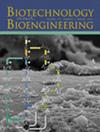A Surface Plasmon Resonance‐Based Integrated Assay for Quantification and Glycosylation Characterization of Monoclonal Antibodies in Crude Heterogeneous Samples
IF 3.6
2区 生物学
Q2 BIOTECHNOLOGY & APPLIED MICROBIOLOGY
引用次数: 0
Abstract
The rise in cancer, autoimmune, inflammatory, and infectious diseases in recent decades has led to a surge in the development of monoclonal antibodies (mAbs) therapies, now the most widely used family of biologics. To meet the growing global demand, biopharmaceutical industries are intensifying their production processes. One approach to achieve more efficient production of effective mAbs is to develop tools for real‐time quality monitoring. Specifically, the glycosylation profile of mAbs must be closely monitored, since it greatly impacts their therapeutic efficacy and innocuity, making it a critical quality attribute. In this study, we developed a surface plasmon resonance‐based integrated assay allowing for the simultaneous quantification and glycosylation characterization of mAbs in crude samples, hence permitting the at‐line analysis of bioreactor cell cultures. Thanks to the high specificity of the interaction between biosensor surface‐bound protein A and the Fc region of mAbs, we quantified crude IgG samples under mass transport limitations. Next, by flowing running buffer on the surface, impurities contained in the mAbs samples were washed away from the biosensor surface, allowing subsequent recording of the kinetics between the captured mAbs and injected FcγRII receptors. Of interest, with this strategy, we were able to quantify terminal galactosylation and core fucosylation of IgG lots, two important glycan modifications for mAb efficacy.基于表面等离子体共振的单克隆抗体定量和糖基化鉴定综合分析
近几十年来,癌症、自身免疫性疾病、炎症和传染病的增加导致了单克隆抗体(mab)疗法的发展激增,单克隆抗体是目前使用最广泛的生物制剂家族。为了满足日益增长的全球需求,生物制药行业正在加强其生产过程。提高单克隆抗体生产效率的一种方法是开发实时质量监测工具。具体来说,必须密切监测单克隆抗体的糖基化谱,因为它极大地影响了它们的治疗效果和无害性,使其成为一个关键的质量属性。在这项研究中,我们开发了一种基于表面等离子体共振的综合分析方法,可以同时定量和糖基化表征粗样品中的单克隆抗体,从而允许对生物反应器细胞培养物进行在线分析。由于生物传感器表面结合蛋白A与单克隆抗体Fc区相互作用的高特异性,我们在质量运输限制下定量了粗IgG样品。接下来,通过在表面流动缓冲液,将单克隆抗体样品中含有的杂质从生物传感器表面冲洗掉,从而记录捕获的单克隆抗体与注射的FcγRII受体之间的动力学。有趣的是,通过这种策略,我们能够量化IgG批次的末端半乳糖基化和核心聚焦化,这是单克隆抗体疗效的两个重要聚糖修饰。
本文章由计算机程序翻译,如有差异,请以英文原文为准。
求助全文
约1分钟内获得全文
求助全文
来源期刊

Biotechnology and Bioengineering
工程技术-生物工程与应用微生物
CiteScore
7.90
自引率
5.30%
发文量
280
审稿时长
2.1 months
期刊介绍:
Biotechnology & Bioengineering publishes Perspectives, Articles, Reviews, Mini-Reviews, and Communications to the Editor that embrace all aspects of biotechnology. These include:
-Enzyme systems and their applications, including enzyme reactors, purification, and applied aspects of protein engineering
-Animal-cell biotechnology, including media development
-Applied aspects of cellular physiology, metabolism, and energetics
-Biocatalysis and applied enzymology, including enzyme reactors, protein engineering, and nanobiotechnology
-Biothermodynamics
-Biofuels, including biomass and renewable resource engineering
-Biomaterials, including delivery systems and materials for tissue engineering
-Bioprocess engineering, including kinetics and modeling of biological systems, transport phenomena in bioreactors, bioreactor design, monitoring, and control
-Biosensors and instrumentation
-Computational and systems biology, including bioinformatics and genomic/proteomic studies
-Environmental biotechnology, including biofilms, algal systems, and bioremediation
-Metabolic and cellular engineering
-Plant-cell biotechnology
-Spectroscopic and other analytical techniques for biotechnological applications
-Synthetic biology
-Tissue engineering, stem-cell bioengineering, regenerative medicine, gene therapy and delivery systems
The editors will consider papers for publication based on novelty, their immediate or future impact on biotechnological processes, and their contribution to the advancement of biochemical engineering science. Submission of papers dealing with routine aspects of bioprocessing, description of established equipment, and routine applications of established methodologies (e.g., control strategies, modeling, experimental methods) is discouraged. Theoretical papers will be judged based on the novelty of the approach and their potential impact, or on their novel capability to predict and elucidate experimental observations.
 求助内容:
求助内容: 应助结果提醒方式:
应助结果提醒方式:


